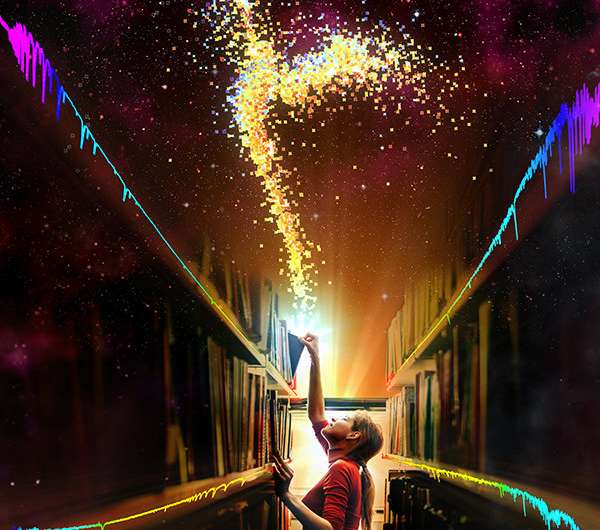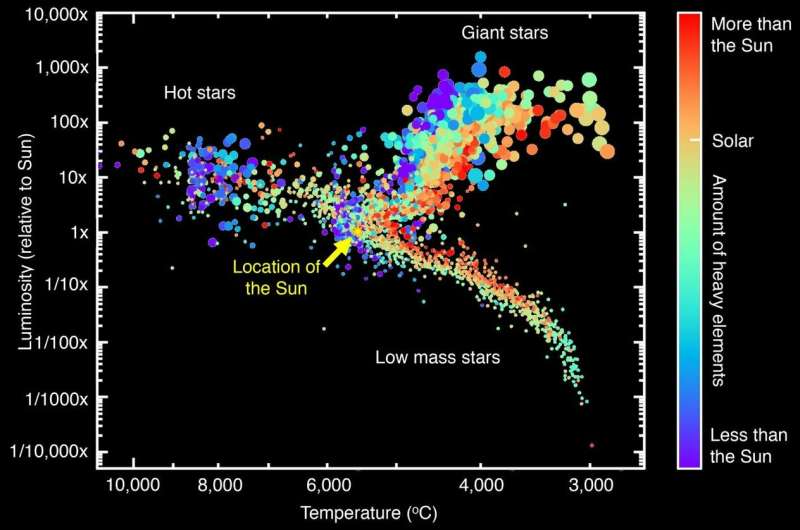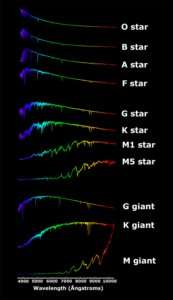In this imaginative visualisation of MaStar, a user of the Stellar Library selects a spectrum corresponding to a certain type of star. Of course, in reality there is no physical library location; the stellar spectra are stored digitally and available to anyone at www.sdss.org. Credit: Dana Berry/SkyWorks Digital Inc.; SDSS collaboration
A new stellar library has been created by UK and US scientists to, for the first time, give us a window of understanding on to our and other galaxies.
Astronomers from the Sloan Digital Sky Survey (SDSS) today announced the opening of a new "stellar library" containing spectra of thousands of stars in the Milky Way.
For decades, astronomers have been trying to figure out what unique mix of stars best explains the light that we see from every distant galaxy. The library will help astronomers understand not only our own Galaxy, but galaxies across the Universe.
The announcement came at the annual meeting of the American Astronomical Society in Seattle, USA.
The new library is known as the "MaNGA Stellar Library," named after the SDSS's Mapping Nearby Galaxies at Apache Point Observatory (MaNGA) survey it was designed to support. MaNGA's goal is to understand the detailed internal structure of galaxies. Because galaxies are made of stars, so understanding a galaxy requires understanding the stars that compose it.
Renbin Yan of the University of Kentucky and Principal Investigator of the MaNGA Stellar Library project, said: "It's a bit like hearing a symphony. We hear the sound from the entire orchestra at once, but we can only understand the music if we know which instruments are playing." For galaxies, the "music" is the light coming from the mix of stars that make up a galaxy, along with its detailed history of star formation. The problem is that other galaxies are so far away that astronomers cannot distinguish individual stars in them. The solution is to study thousands of stars in our own Milky Way. Once they identify all of the possible "instruments" using stars in the Milky Way, they can decipher the "music" of distant galaxies.
A Hertzsprung-Russell diagram of all stars currently in the MaNGA Stellar Library, showing temperature and brightness (luminosity) of stars, along with information on their chemical makeup. Credit: SDSS collaboration
In a symphony, the sound of each instrument has its own unique tone; in the case of galaxies, the light of each type of star has a unique spectrum. A spectrum measures how much light a star gives off at different wavelengths, a pattern unique to each type of star. Like sheet music shows how a song will sound, "reading" a spectrum gives important information about a star, including its temperature, size and chemical composition.
By observing thousands of stars of all types, astronomers can build up a "library" of stellar spectra.
Claudia Maraston, Professor at the University of Portsmouth and local Principal Investigator of the project, said: "With such a library in hand, we can make complex models of galaxies and their light emitted from the combination of billions of different stars. Such models are crucial for astrophysics and cosmology."
The accurate spectra come from the spectrograph of the Mapping Nearby Galaxies at APO (MaNGA) programme, one of the SDSS's component surveys. MaNGA spends most of its time observing galaxies, but over the past three years, it has also measured spectra for more than 3,000 stars of all colours and sizes. These spectra have been collected into the MaNGA Stellar Library, or MaStar for short.
The MaNGA stellar library began out of necessity. At the beginning of the fourth phase of the SDSS in 2010, the MaNGA team realised that there was no suitable library of stellar spectra covering the wavelength range that MaNGA would use.
Daniel Thomas, Professor at the University of Portsmouth and former Science Team Chair of the MaNGA project said: "While the MaNGA team has already done a lot of fascinating science, the best is yet to come. We are all hugely excited about using our new models based on the MaStar library to decipher the music of distant galaxies."
Each coloured curve in this image shows the spectrum for one star in the MaNGA Stellar Library. The curves show the wavelengths of light, covering the entire visible spectrum and beyond, from ultraviolet to infrared (from left to right). The height of each the curve at each point shows the intensity of light at that wavelength. The peaks and valleys of each curve indicate the presence of different chemical elements. The top eight curves are for typical stars, labelled with their spectral type and sorted in order of temperature – the O star (top) is the hottest, while the M5 star (eighth from top) is the coolest (the Sun is a G star). The bottom three spectra are for giant stars, again sorted from hottest to coolest. Credit: Renbin Yan (University of Kentucky); SDSS collaboration
The MaStar project was made possible by the parallel observing capability in SDSS. At the same time as their colleagues use the infrared spectroscope to observe stars in our Galaxy, the MaStar team can use the MaNGA instrument to simultaneously observe other stars in the optical. This is enabled by the way SDSS uses fibres to observe the light from many stars at once.
This strategy of "piggybacking" on other SDSS observations allowed researchers from the MaNGA team to get the right spectra for the right stars to create the stellar library they so desperately needed.
All the spectra for all these stars have been released as part of the SDSS's Data Release 15, and are available online through the project's website at www.sdss.org.
Once astronomers have a library that includes the light spectra for as many types of stars as possible, they can figure out how many of each type of star add up to make the galaxy spectrum, allowing them to understand the galaxy's history of star formation. In Yan's analogy, they can understand which instruments are making the music. The key is to include as many types of stars as possible in the library.
Professor Maraston said: "MaStar is the most complete and most comprehensive stellar library ever created,". "It will allow us to make the most accurate models of galaxies to date."
The MaNGA Stellar Library is expected to keep growing. With observations continuing at Apache Point Observatory until at least 2020, it will become the biggest and most inclusive stellar library ever made.
Provided by University of Portsmouth


























